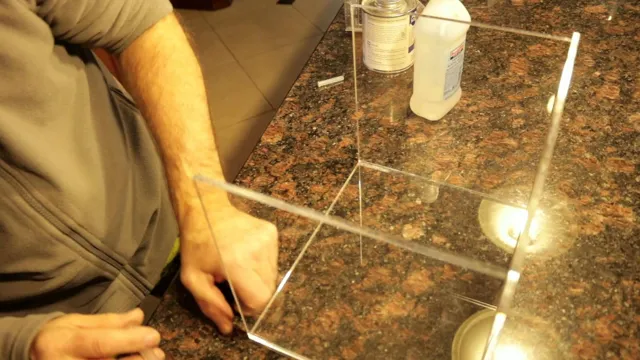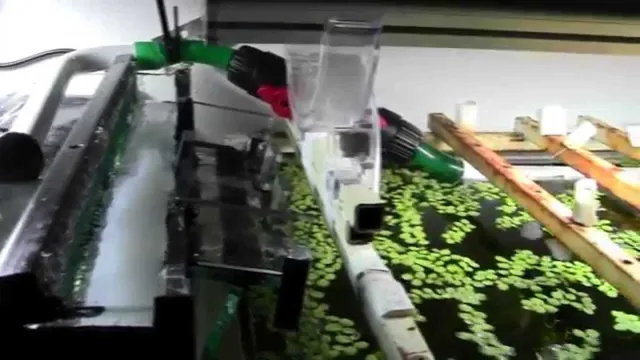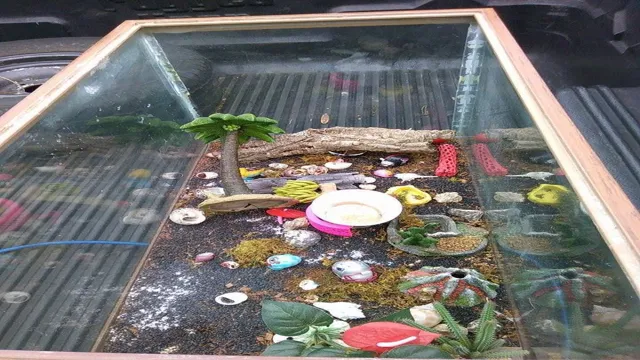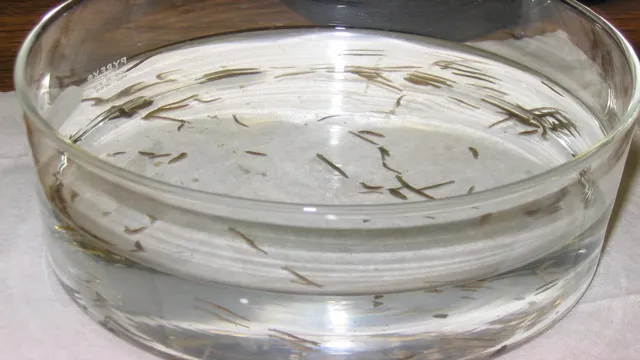As an aquarium owner, ensuring the safety and comfort of your fish is of utmost importance. One crucial aspect of aquarium maintenance is gluing acrylic for aquariums. Acrylic glue is a special adhesive that is used to bond the acrylic panels together to create a water-tight seal in your aquarium.
It is crucial to use the right type of glue and application method to ensure the longevity of your aquarium. Gluing acrylic for aquariums may seem like a daunting task, but with a few tips and tricks, it can be a breeze. In this blog post, we’ll explore the basics of gluing acrylic for aquariums and provide you with all the information you need to ensure a successful bonding process.
So, let’s dive in!
Understanding Acrylic Glue
Are you interested in creating your own aquarium? If so, you need to know how to glue acrylic for aquariums. Acrylic glue is the ideal option for this project because it bonds quickly and securely. It’s important to note that not all acrylic glues are the same, so you need to choose the right one for your needs.
When selecting acrylic glue, consider factors such as its strength, curing time, and flexibility. It’s also crucial to prepare the bonding surfaces correctly before gluing. Clean the surfaces with a solvent and allow them to dry thoroughly.
Next, apply the acrylic glue to one surface and join the two pieces together. Hold the pieces in place for a few minutes until the glue sets. By following these steps, you’ll be able to glue acrylic for your aquarium like a pro!
Types of Acrylic Glue
Acrylic glue is a versatile adhesive that has numerous uses across industries. It is composed of various acrylic polymers and can be either a two-part adhesive or a single component adhesive. The two-part adhesive requires mixing before application, while the single-component glue can be used directly out of the container.
Understanding the different types of acrylic glue available in the market is vital in choosing the right adhesive for the job. There are mainly four types of acrylic glue: water-based, solvent-based, heat-cured, and UV-cured. Water-based acrylic glue is eco-friendly and easy to clean up.
Solvent-based acrylic glue is ideal for fast-drying, high-strength applications. Heat-cured and UV-cured acrylic glue is suitable for bonding non-porous materials and provides excellent bonding strength in high-stress applications. In summary, acrylic glue is a versatile and robust adhesive that can bond a wide range of substrates.
Knowing the different types available is crucial in selecting the right adhesive for the job.
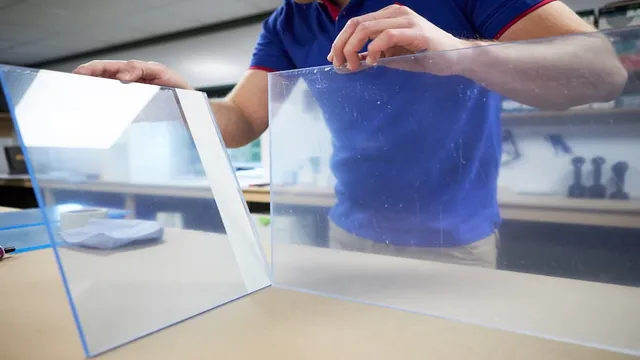
Cyanoacrylate Glue
Cyanoacrylate glue, also known as acrylic glue, is a fast-drying adhesive that’s widely used in various industries. This glue is made by mixing cyanoacrylate monomers with activators, which trigger the polymerization process. Once applied, cyanoacrylate glue bonds quickly to most surfaces, including plastics, metals, and ceramics.
However, it’s important to note that this type of adhesive can be brittle, making it unsuitable for certain applications that require flexibility or shock resistance. Additionally, cyanoacrylate glue can be difficult to remove once it has cured, so it’s essential to use it sparingly and avoid contact with skin or eyes. Despite its limitations, acrylic glue has many advantages, including easy and fast application, high bond strength, and the ability to work well in tight or hard-to-reach areas.
Whether you’re in the manufacturing, automotive, or construction industry, cyanoacrylate glue can be a valuable tool for your projects.
Methyl Methacrylate Adhesive
If you’re looking for a strong adhesive that can bond a variety of materials together, you might want to consider methyl methacrylate adhesive, also known as acrylic glue. This type of adhesive is made from two components: a resin and a hardener. When combined, they create a strong, clear glue that can bond plastics, metals, and even ceramics.
One of the benefits of using acrylic glue is that it dries quickly, which makes it ideal for fast-paced manufacturing processes. Additionally, it can withstand high temperatures and is resistant to water and chemicals, making it a popular choice in the automotive, aerospace, and construction industries. So if you’re looking for a versatile and reliable adhesive, consider giving acrylic glue a try. (See Also: Is Clear Gorilla Glue Aquarium Safe? Expert Answers and Tips)
Preparing for Gluing
If you’re looking to build an acrylic aquarium, you’ll need to know how to glue acrylic. It’s a different process than gluing other materials since acrylic is prone to cracking and requires specific preparation. Before you begin, make sure to thoroughly clean the surfaces that will be bonded.
Any dirt or debris can weaken the bond and compromise the strength of the aquarium. It’s important to also create a beveled edge on the edges that will be joined together. The bevel ensures that the glue has more surface area to bond to, increasing the strength of the joint.
Once the edges have been beveled, use a solvent-based acrylic cement to glue the pieces together. Only use enough glue to cover the edge of the bevel and avoid using too much pressure when joining the pieces together. Following these steps will give you a sturdy and long-lasting bonding for your acrylic aquarium.
Clean and Dry Acrylic
When working with acrylic, it is always important to prepare the surface properly before gluing. One of the most crucial steps in this process is ensuring that the acrylic is clean and dry. Any dirt, dust, or moisture can prevent the glue from properly adhering to the surface, leading to a weak bond or even complete failure.
To clean acrylic, use a mild soap and water solution, avoiding any harsh chemicals or abrasives that could scratch or damage the surface. Once clean, be sure to fully dry the acrylic using a soft, lint-free cloth or air dryer. This will ensure that the surface is properly prepared for the glue to bond effectively.
By taking the time to properly prepare your acrylic surface, you can guarantee a strong and long-lasting bond for your project.
Secure Acrylic Pieces in Place
When it comes to securely gluing acrylic pieces in place, preparation is key. This means ensuring that the pieces fit together perfectly, without any gaps or misalignments. If there are any imperfections in the fitting, the glue won’t be able to hold the pieces securely, leading to the risk of the project falling apart.
To ensure a perfect fit, take the time to carefully measure and align each piece before moving on to the gluing stage. This will help to ensure that your project stays firmly in place and that you can enjoy your hard work for years to come. Remember, the key to successful gluing is preparation, so don’t rush this step if you want to avoid any mishaps down the line.
Gluing Process
If you’re looking to build an aquarium, one important step is how to glue the acrylic sheets together. First, make sure you have the right adhesive for the job. A two-part methacrylate adhesive is recommended for its high strength and ability to withstand water.
Before gluing, clean both surfaces with a mild detergent and dry them thoroughly. Apply a thin layer of adhesive to one surface, then press the two pieces together with firm pressure for several minutes. Make sure the pieces are aligned properly before the adhesive sets.
Finally, let the adhesive cure completely before filling the aquarium with water. Proper gluing is essential for the structural integrity of the tank, so take your time and follow these instructions carefully. Remember to always wear protective gear and work in a well-ventilated area.
With a little patience, you can create a beautiful and functional aquarium that will give you years of enjoyment.
Apply Glue to One Surface
When it comes to the gluing process, it’s essential to remember to apply glue to only one surface. Many people make the mistake of applying glue to both surfaces they want to join, but this can actually weaken the bond. Instead, applying glue to just one surface will ensure a stronger and more secure hold. (See Also: How to Get from Osaka Station to Osaka Aquarium: A Complete Guide)
The reason for this is because the glue needs to be able to penetrate into the material and create a chemical bond. When glue is applied on both surfaces, there’s a higher chance of air bubbles being trapped between the two pieces, and the glue won’t be able to penetrate as effectively. Hence, when applying glue, it’s crucial to apply it evenly and thinly to one surface and then press the two surfaces together firmly but without sliding or shifting them around.
Doing so will give you the best chance of creating a solid and long-lasting bond. So remember, always apply glue to just one surface!
Press Surfaces Together Carefully
When it comes to gluing objects together, one of the crucial steps is to press the surfaces carefully. This ensures that the adhesive is distributed evenly and that there are no gaps or air pockets between the two surfaces. It’s important to take your time during this process and apply consistent pressure across the entire area.
This can be done using a clamp or by simply pressing down with your hands. Make sure to check the manufacturer’s instructions for the recommended amount of pressure and drying time. Rushing this step or not applying enough pressure can result in a weak bond that may break or come apart easily.
Remember, a strong bond begins with proper surface preparation and careful pressing during the gluing process.
Drying and Curing Time
When it comes to building an acrylic aquarium, choosing the right adhesive is crucial in ensuring its strength and longevity. While there are various types of glue available in the market, not all of them are suitable for acrylic. The best option is to use a specialized acrylic adhesive.
Before applying the adhesive, make sure that the edges of the acrylic sheets are clean and free from any debris or oils. Once the adhesive is applied, it is essential to let it dry and cure properly. The drying time can vary depending on the humidity and temperature.
It is recommended to wait for at least 24 hours before handling the glued acrylic pieces. However, the curing time can take up to several weeks or even months. It is crucial to follow the manufacturer’s instructions for curing time as a premature attempt to use the aquarium can cause the adhesive to fail, resulting in leaks and damage.
By following the proper processes and using the right adhesive, you can ensure a sturdy and leak-proof acrylic aquarium that will last for many years.
Allow Sufficient Drying Time
When it comes to painting, one of the most important steps is allowing sufficient drying time. This is true for both interior and exterior painting projects. Drying time refers to the amount of time it takes for the paint to dry on the surface, whereas curing time is the amount of time it takes for the paint to fully harden and reach its maximum durability.
It’s crucial not to rush the drying and curing process, as doing so can compromise the overall quality of the paint job. Factors such as humidity, temperature, and the type of paint being used can all impact the drying and curing time. In general, latex paints tend to dry faster than oil-based paints.
It’s important to follow the manufacturer’s instructions for drying and curing times, which can vary between products. Rushing through the painting process can lead to a finished product that looks unprofessional and lacks durability. So, be patient and allow sufficient time for the paint to dry and cure for beautiful and long-lasting results.
Curing Acrylic Glue
Acrylic glue is a popular adhesive used to bond a variety of materials together, from plastics to metals to wood. However, one important step in ensuring a successful bond is properly curing the glue. To begin with, it is important to note that drying time and curing time are two different things.
Drying time refers to the time it takes for the adhesive to become tacky and set, while curing time refers to the time it takes for the adhesive to fully harden and reach its maximum strength. In general, acrylic glue can take anywhere from 24 to 48 hours to fully cure, depending on factors such as temperature and humidity. It is important to give the glue sufficient time to cure before subjecting the bonded materials to any stress or strain. (See Also: How to Create a Temporary Aquarium Heater Using Everyday Items)
Additionally, keep in mind that some types of acrylic glue may require specific curing conditions, such as the use of UV light or heat. By properly following the recommended curing instructions, you can ensure a strong and long-lasting bond for your project.
Conclusion and Safety Tips
In conclusion, gluing acrylic for aquariums may seem daunting at first, but with the right tools and techniques, it can be a fantastic DIY project. Just remember to use specialized acrylic glue, prep the surfaces properly, and work efficiently while the glue is still wet. With these tips in mind, your aquarium will have a strong and seamless bond that’s sure to impress all your fish-loving friends.
So dive in and give it a try – your aquatic pets will thank you for it!”
FAQs
What type of glue is best for acrylic aquariums?
The best type of glue for acrylic aquariums is a solvent cement that is specifically designed for bonding acrylic.
How do I prepare the surfaces before gluing acrylic for my aquarium?
Before gluing acrylic for your aquarium, you should clean and dry the surfaces, and then roughen them with sandpaper.
Can I use regular super glue for gluing acrylic for my aquarium?
You should not use regular super glue for gluing acrylic for your aquarium because it will not bond well and may not hold the weight of the water.
Can I glue acrylic for my aquarium underwater?
No, you cannot glue acrylic for your aquarium underwater. You need to dry the surfaces before applying the glue to ensure a proper bond.
How long does it take for the glue to dry when gluing acrylic for my aquarium?
The drying time of the glue depends on the type of glue you are using and the temperature and humidity of the environment. It can take anywhere from a few hours to a full day.
Is it safe to use glue for gluing acrylic for my aquarium?
Yes, it is safe to use glue for gluing acrylic for your aquarium as long as you follow the instructions and use a glue that is specifically designed for acrylic.
What should I do if I make a mistake while gluing acrylic for my aquarium?
If you make a mistake while gluing acrylic for your aquarium, you should try to separate the pieces before the glue dries. You can use a solvent to dissolve the glue or gently pry the pieces apart.

